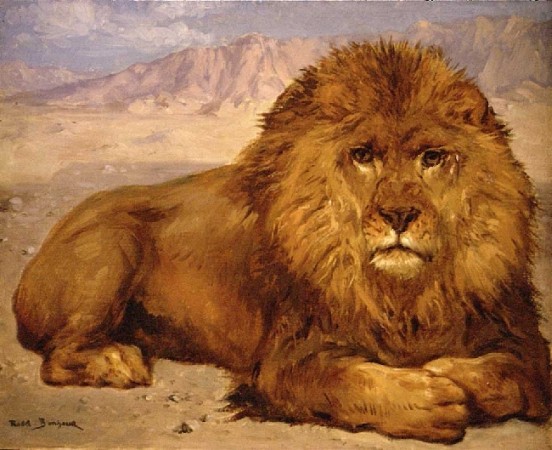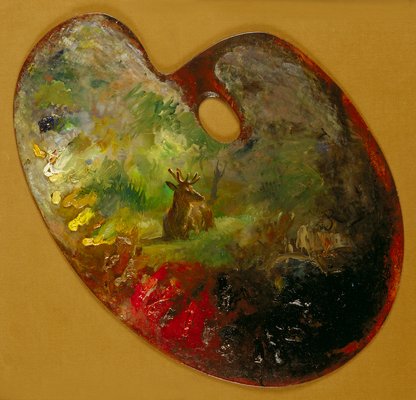| Rosa Bonheur
The Art History Archive - Biography, Quotations & Art
ROSA BONHEUR
Rarely during the nineteenth century did the artistic career and recognition of a woman eclipse that of her male counterparts. History recognizes few females from this period in the position of artistic authority, but Rosa Bonheur established herself as the foremost “animalier,” or animal painter, linked with landscape painting and the Realist tradition. Through contacts, exhibitions, and reproductions disseminated worldwide, Rosa Bonheur’s work was well known throughout Europe and America. Her unusual ways attracted considerable public attention and she harnessed this interest throughout her life and established a niche, commercially and artistically, for her work, becoming one of the most original figures of the 19th century. Marie-Rosalie Bonheur was born March 16th, 1822 in Bordeaux, France. She was one of four children, each trained as an artist. Most influential in her life, both artistically and socially, was her father, Oscar-Raymond Bonheur, also a trained artist and devout socialist. During Rosa’s childhood, Raymond was involved with the Saint-Simonians, a political group established in the small town of Menilmontant. The Saint-Simonians advocated a form of socialism which expressed a desire for the equality of women and men and abolishment of class distinctions, among other goals. While radical in its political and social nature, the Bonheur family supported Raymond in this idealist pursuit of social unity and amelioration. Raymond’s association with this group contributed to Rosa’s liberal outlook and defiant personality leading to her dressing as a male, cutting her hair short, and smoking cigarettes and cigars much to the disdain of and the misunderstanding of many. Her actions and personality have placed her in a decisive position in early feminism. She wrote that “To [my father’s] doctrines I owe my great and glorious ambition for the sex to which I proudly belong and whose independence I shall defend until my dying day.” More important for Rosa’s work was Raymond’s respect for the writings of Georges Sand and Felicité Robert de Lamennais, who believed that every living creature had a soul, creating a sense of respect within Rosa for the animals of the natural world. She would later own many animals, including horses, lions, and even an otter. Her love of animals translated into amazingly precise and interpretive depictions of their very nature and physiognomy. With these ideas fresh in her mind and after failed attempts at boarding school and an apprenticeship with a dressmaker, Rosa began her artistic training with her father at the age of thirteen. She never attended formal art classes such as the traditional École des Beaux-Arts (women were not allowed at this time), but progressed under the artistic tutelage of her father. She began her training with the standard procedures of copying engravings and plaster casts, drawing still-lifes, and later copying paintings of the masters in the Louvre. This was typical training for art students but certainly atypical for a female. Though several of these copies were quickly sold, Raymond considered this insufficient training and encouraged his children to sketch directly from nature. In 1842, the family moved to the Rue Rumford, a section of Parisclose to fields, farms, and animals, where Rosa and her siblings could develop their immense talent through realistic drawing and painting. She was said to also frequent “masculine” areas such as horse fairs and the slaughterhouses of Paris in order to gain a deeper understanding of the ranges of animal emotion and physiognomy, however gruesome the latter may have been. Rosa also gained more training and further developed her talent while working with her siblings on her father’s commissions. Raymond continued the tradition of the family workshop, which had fallen out of favor in the 19th century. Raymond’s career as an artist burgeoned and in order to meet the demand for his works, he began to employ his children’s assistance to complete commissions. From this point, the Bonheur children established their own artistic careers but continued to assist one another in order to complete commissions.
In 1851, Bonheur established a relationship with the house of Goupil in Paris. Throughout the next years her painted images would be reproduced by Lefèvre in London and Goupil and Peyrol in Paris, disseminating her name and image, thereby increasing her fame beyond the scope of Salon visitors and clients. The pinnacle of Rosa’s artistic career was Le Marché aux Chevaux (The Horse Fair), also begun in 1851 and submitted to the 1853 Salon after 18 months of preparatory work. In her book entitled Rosa Bonheur: With a Checklist of Works in American Collections, Rosalia Shriver describes the monumental nature of this submission:
After the Salon of 1853, Rosa was declared “hors de concours”, exempting her from the necessity of submitting further Salon entries for acceptance. She did exhibit Fenaison d’Auvergne (Haymaking in the Auvergne) at the Salon of 1855 for which she was awarded another gold medal. This was her last entry until the Exposition Universelle of 1867. Le Marché aux Chevaux (The Horse Fair) established Rosa’s international fame, and was sent to Ghent, Belgium where the important Belgian art dealer Ernest Gambart noticed and later purchased it. Gambart had an office in London and convinced Rosa and Nathalie into coming to London to tour with the painting, solidifying her prestige as an internationally acclaimed animalier. During this period, with her success in England and the United States, Rosa became fascinated with the United States, the “new world.” Her interest was first piqued in 1854 when the painter George Catlin and a group of Indians paraded through the streets of Paris. It was later solidified in 1889 when Buffalo Bill Cody came to the Exposition Universelle with his Wild West show and his band of Indians in their colorful costumes. She had a fondness for the United States and its perceived vast frontiers and wild animals. Her interest in the United States would later translate into an important and special relationship between her and Anna Klumpke, a young artist from California, who became Rosa's special companion until her death. Rosa found her fame rather distressing. In 1859, she retreated from Paris and established permanent residence at By, near the Forest of Fontainebleau. While working near the Barbizon painters, she did not associate with them. During her stay at By she greeted many people of great prestige, such as the Empress Eugènie, and also opened her home to others during the Franco-Prussian War of 1870-71. With her ardently political nature, Rosa was ready to fight for the cause of her country but with considerable persuasion she did not engage in actual combat. Rosa continued to work fervently on sketches, paintings, and commissions for the next forty years until her death on May 25th, 1899. She was seventy-eight years old. After Rosa’s death, Anna Klumpke went through her studio and found 892 paintings and several boxes of drawings, all sorted and dated. The items were sold shortly after her death, grossing over 2 million francs, an immense sum at the time.
Rosa Bonheur will be remembered for her fidelity to nature and her animals. Her understanding of and love for the subject was projected through her luminous and realistic depictions, while at the same time she did not trivialize the subject. She will also be remembered for her fiery independent character. A later discussion of Rosa Bonheur by Paul-Louis Hervier in the 1908 La Nouvelle Revue wrote that Rosa was: Simple, welcoming, of an extreme frankness, she was loved by all; because of her good heart, her generosity, her simplicity, which were not studied but spontaneous, she acquired the well deserved reputation of a beneficent fairy. Rosa Bonheur’s illustrious career garnered her many prestigious accolades usually reserved only for men. The following is a list of some of her international honors: honorary member of the Pennsylvania Academy of Fine Arts and of the Société des Artistes Belges (1863); Chevalier de la Légion d’Honneur, the first woman artist to receive this honor, and the Cross of San Carlos of Mexico, awarded to her by Emperor Maximilian and Empress Carlotta (1865); membership in the Académie des Beaux-Arts of Antwerp, Belgium (1868); Commander’s Cross of the Royal Order of Isabella (by Spain’s Alphonso XII), Catholic Cross and the Leopold Cross presented by Leopold of Belgium (1880); honorary member of the Royal Academy of Watercolorists of London and Mérite des Beaux-Arts de Saxe-Coburg-Gotha (1885); and Officier de la Légion d’Honneur, the first woman to be honored in this position (1894). Paintings by Rosa Bonheur: |
|
|
Quotes by Rosa Bonheur: But the suit I wear is my work attire, and nothing else. I preferred to preserve my name. I was forced to recognize that the clothing of my sex was a constant bother. That is why I decided to solicit the authorization to wear men's clothing from the prefect of police. The epithets of imbeciles have never bothered me. To his doctrines I owe my great and glorious ambition for the sex to which I proudly belong and whose independence I shall defend until my dying day.
More info on Rosa Bonheur: Ahead of her time in the way she dressed and behaved French painter Rosa Bonheur led the way for a generation of women artists. Known throughout her life as an eccentric with a forceful personality the French artist Rosa Bonheur took a traditional route when it came to her chosen career. Born on March 16, 1822 in Bordeaux, France Rosa’s parents were to provide her with a strong non-conformist background whilst encouraging her artistic ability. Her mother, Sophie Bonheur, taught her the alphabet by drawing animals next to each letter imbuing a love of nature and art from an early age. Her father, Raimond Bonheur, a unsuccessful landscape painter who held extremely strong socialist beliefs, belonged to a number of unusual groups throughout his lifetime, even living in a monastery at one time. After failing to make a living as an artist Raimond was forced to take up teaching as a profession and moved to Paris in 1828. Despite this however the family still struggled and after giving birth to another daughter and two sons Sophie died in 1833 when Rosa was only 11 years old. Females were discouraged from attending art school in the 19th century Rosa was indeed fortunate that her father took the time to tutor and encourage her interest in art. From age 10 she spent time sketching animals in the parks surrounding Paris and Raimond also allowed her to keep a variety of pets including a pet sheep, which she housed on the balcony of the family’s 6th floor apartment. By age 17 she was earning money to help supplement the family income by making copies of paintings in the Louvre. In particular she was strongly influenced by the work of the English animal painter Edward Landseer. Rosa also studied anatomy by visiting slaughterhouses and performing dissections in order to study the animals’ bone and muscle structure. She then used this information in her preparatory sketches and studies before beginning to work on her paintings.Bonheur weaning the calves Rosa cut a controversial figure in her time. Smoking cigarettes in public she also rode astride, had short hair and wore men’s clothing (she once had to ask permission from the police in order to wear trousers and a smock so that she could work undisturbed while sketching at a horse fair). Not conventionally beautiful on one occasion she was arrested while wearing female attire by a gendarme who thought she was a man dressed as a woman! On leaving home Rosa lived with female companions: for 50 years she shared her life with Nathalie Micas whom she had met in her teens and who died in 1889 leaving her heartbroken. Afterwards she became attached to the American artist Anna E. Klumpke. As a young artist Rosa exhibited animal paintings and sculpture at the Paris Salon during 1841-1853 winning a third prize in 1845 and a gold medal in 1848. The Salon was renown for supporting traditional artists and in this Rosa did not disappoint them although her work was devoid of the sentimentalism inherent in so much of the work of other 19th century animal painters. From this initial success at the Salon she was awarded a commission from the French Government to paint a work on the subject of ploughing. “Plowing in the Nivernais” was later exhibited at the Salon in 1849 and firmly established her reputation. However her most famous work “The Horse Fair” (1853) was the painting which won her international acclaim and garnered her many well-known admirers. Chief among these was Queen Victoria who ordered a private viewing of the work at Windsor Castle. In fact so popular did Rosa become in England that her chief source of income during the 1860s-70s came from that country.Bonheur the horse fair Throughout a long and illustrious career Rosa went on to accumulate many awards. She was the first woman to win a cross of the Legion d’Honneur for outstanding achievement in her field. The Empress Eugenie, wife of Napoleon III, bestowed this on her in June 1865 stating as she did so that “genius has no sex”. Other honours included awards from the Great Exhibit of London 1862, the Paris Exposition Universalle 1867, and the Chicago Words Colombian Exposition in 1893. Retiring to a chateau near Fontainebleau, which she called “The Domain of Perfect Affection” Rosa spent much of her time with a menagerie of animals that included bears and lions and well as writing prolifically. When she died in 1899 her ashes were buried in the Pere Lachaise Cemetery in Paris along with those of the two women with whom she had shared her life.
Museums & Galleries that show her work:
The following books document the life of Rosa Bonheur:
| |
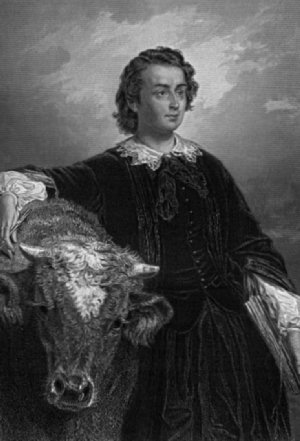
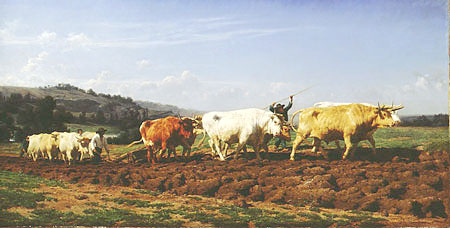 While untraditional, Rosa gained important training through her lessons with her father and as a collaborator (on his commissions). From the beginning of her career Rosa was most interested in depicting animals and the natural world and rarely deviated from that. She debuted at the Paris Salon in 1841 with Chèvres et Moutons (Goats and Sheep) and Lapins (Rabbits Nibbling Carrots). This began a long and illustrious continuum of works exhibited at the Salon. By the age of 23, Rosa had already exhibited eighteen works at the Paris Salon. Early in her career, she also exhibited sculptures at the Salon, though decided to abandon this as her brother, Isidore, was a gifted sculptor and Rosa did not want to overshadow him. In 1848 she was given her second medal, this time a gold medal. Upon this success, she began sketching for her Labourage Nivernais (Plowing in the Nivernais), said to have been commissioned by the state, which was later exhibited at the 1849 Salon. It was also during this year that Rosa’s father died and she succeeded him as directress of the École Gratuite de Dessins des Jeunes Filles, while also establishing her own studio with her companion, Nathalie Micas, at 56 rue de l’Ouest.
While untraditional, Rosa gained important training through her lessons with her father and as a collaborator (on his commissions). From the beginning of her career Rosa was most interested in depicting animals and the natural world and rarely deviated from that. She debuted at the Paris Salon in 1841 with Chèvres et Moutons (Goats and Sheep) and Lapins (Rabbits Nibbling Carrots). This began a long and illustrious continuum of works exhibited at the Salon. By the age of 23, Rosa had already exhibited eighteen works at the Paris Salon. Early in her career, she also exhibited sculptures at the Salon, though decided to abandon this as her brother, Isidore, was a gifted sculptor and Rosa did not want to overshadow him. In 1848 she was given her second medal, this time a gold medal. Upon this success, she began sketching for her Labourage Nivernais (Plowing in the Nivernais), said to have been commissioned by the state, which was later exhibited at the 1849 Salon. It was also during this year that Rosa’s father died and she succeeded him as directress of the École Gratuite de Dessins des Jeunes Filles, while also establishing her own studio with her companion, Nathalie Micas, at 56 rue de l’Ouest.
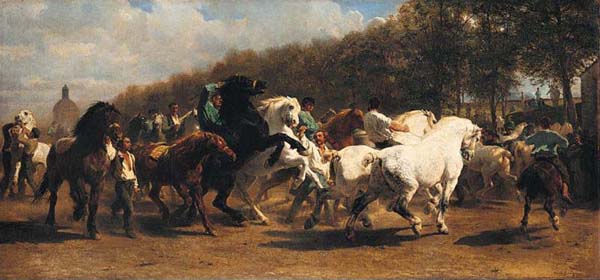 When it was finally finished and exhibited at the Salon of 1853, its creator was only 31 years old. Yet no other woman had ever achieved a work of such force and brilliance; and no other animal painter had produced a work of such size.
When it was finally finished and exhibited at the Salon of 1853, its creator was only 31 years old. Yet no other woman had ever achieved a work of such force and brilliance; and no other animal painter had produced a work of such size.
